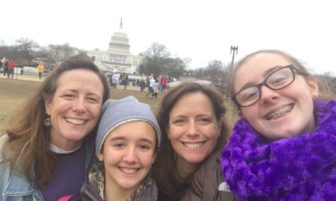The morning after Donald J. Trump was elected president, Kathy Fischer was greeted by her annoyed 15-year-old, Kelly. Election night was also a school night and the results were coming in slowly. Fischer, associate director of UConn’s Women’s Center, had promised she’d wake daughter Kelly after their candidate, Hillary Clinton, won.
![]() But when Fischer told her daughter the actual results, Kelly was stunned. Trump had let it be known he would not support a progressive agenda, or one that supports women. And yet here he was elected the 45th president.
But when Fischer told her daughter the actual results, Kelly was stunned. Trump had let it be known he would not support a progressive agenda, or one that supports women. And yet here he was elected the 45th president.
So, when word went out that there was a women’s march on Washington being planned for the day after Trump’s inauguration, Kathy Fischer signed up.

Kristin Fischer, Gabrielle Fluckiger, Kathy Fischer, and Kelly Fluckiger at the Women’s March in Washington, D.C.
And early Saturday morning, Kathy, Kelly, and 13-year-old Gabrielle, joined Kathy’s twin sister, Kristin, on a bus in Middletown packed to the gills with women, men, and children anxious to make a show of force against what mostly likely will be coordinated and constant threats to social justice during Trump’s time in the White House. What started as a series of anguished post on Facebook became the Women’s March on Washington, one of the largest demonstrations in the nation’s capital.
With hundreds of thousands of others, they traveled to D.C. and spilled out onto streets packed with people, many of them in pink pussyhats, which were worn in protest of one of the new president’s more salacious comments about women.
In fact, that comment inspired some of the day’s more creative protest signs, which included “Pussy Grabs Back,” “Tweet Women With Respect,“ and “Not Usually A Sign Guy But Geez.” One woman from California walked with a string of tiny plastic hands stretched on a red string held over her head.
To get to the epicenter of the march—the Capitol and the Capitol Mall—Connecticut marchers walked down Washington streets to the cheers of residents coming out of their townhouses to thank them for marching. Traffic cops thanked them. Taxi drivers thanked them. A woman who was working a trolley—that ran for free—teared up at one Connecticut contingent and thanked them. She said she’d wanted a pussyhat, and when one of the state’s organizers, Sarah Raskin, handed over hers, “she literally did a little dance saying we all had ‘touched her heart,’” said Raskin, Trinity College professor of psychology and neuroscience.
Organizers of the march expected 200,000. They got more than twice that many, and they were joined in sister marches around the world, including one in Hartford that drew 10,000, and another in Stamford, which at 5,000 marchers was four times larger than organizers expected.
The march was one of the first times, Raskin said, that she saw people understanding the connections between issues such as paid sick leave, economic justice, and racial disparity in our jails. “That really all this was about was equality and justice,” Raskin said. “Women’s Rights Are Human Rights, Black Lives Matter, Love Is Love Is Love, We Are Here to Stay are not separate identity issues but synonyms, examples for the words justice and equality.”
The march, she said, “was a gathering of people who choose both hope and action. People were friendly, quickly bonding with strangers, helping each other out, laughing and sharing stories. And without question, the phrase I heard more than any other was ‘This is not a moment, it’s a movement.’”
More than 4,000 Connecticut residents rode to D.C. on 80 buses. Who knows how many more traveled on trains and in cars? National organizers are trying to get a head count. People who attended any of the marches can text “Count me” to 89800.
So now, the real work begins. Most of us couldn’t get close enough to the stage to hear anything but muffled words, and that’s OK. What we traveled for, and what we brought back, was fire in the belly. Swords up, ladies.
Susan Campbell is a distinguished lecturer at the University of New Haven. She can be reached at slcampbell417@gmail.com.
Susan- morning Joe says there are places where women can sign up and unite to organize; he says they’ll lose impact if they don’t do this; I agree – do you know places where I can sign up – I have severe Lyme disease right now and can’t March but I could sign up. If you know please let me know .
Hello, Carol. Not being at the march is not a barrier to getting involved, I promise. That was just a kick-off. There are all kinds of actions going on that don’t take mobility. The Women’s March organizers, for example, have a plan for 10 actions over the next 100 days. Here’s a link and good on you. Swords up: https://www.womensmarch.com/100/ And I’ll keep you in my thoughts. I have family members living with Lyme. It’s awful.